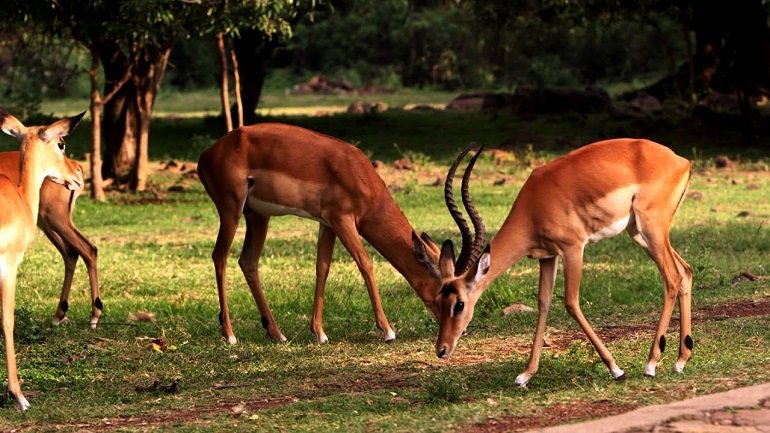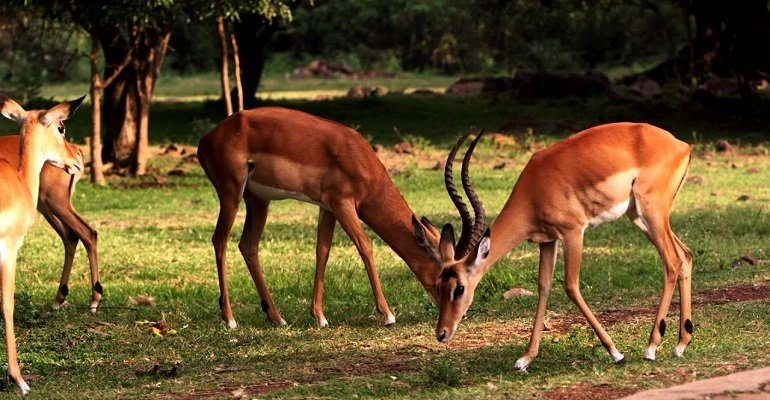
Imagine you’re at a bustling buffet, trying to select the best bites while keeping an eye on who might be lurking nearby to snag your meal. For an impala, the savanna is just that—a huge buffet filled with delicious grasses and leaves, all while being on high alert for predators like lions or hyenas. In this article, we’ll dive into what impalas eat, how they forage, and how they evade their hunters. It’s a world of survival, strategy, and a little bit of luck!
Understanding the Impala’s Diet
The impala’s diet is largely herbivorous, meaning they primarily eat plants. They are selective grazers, which means they tend to choose high-quality grasses and leaves. Impalas thrive on grasses, especially during the rainy season when they’re lush and full of nutrients. Here’s what you need to know about their eating habits:
- Grasses: Impalas prefer short, tender grasses. This selection is not just about taste; it ensures they get essential nutrients without the struggle of breaking down tougher plant materials.
- Leaves: When grass is scarce, impalas will munch on the leaves of shrubs and trees. Their high adaptability allows them to survive even when food options are limited.
- Fruits and Flowers: Occasionally, impalas will nibble on fruits and flowers. This variety not only adds to their diet but also helps them stay hydrated, especially in dry conditions.
You might wonder how impalas get the energy they need for all that running around. Well, they have a unique digestive system that allows them to efficiently extract nutrients from their food. While they’re pretty good at finding food, they also need to be mindful of when and where they eat.
Foraging Techniques of Impalas
Foraging isn’t just a matter of chomping down on anything green. Impalas are smart eaters, and they’ve developed some effective strategies to find food. Here’s a closer look at their foraging techniques:
- Herd Behavior: Impalas often forage in groups. This strategy not only helps them find food more quickly but also provides safety in numbers. With lots of eyes on the lookout, they can spot threats sooner.
- Selective Grazing: As mentioned earlier, they are picky eaters. When choosing grass, impalas will often avoid areas that look trampled, indicating that predators or other animals have been around.
- Time of Day: Impalas are crepuscular, which means they’re most active during dawn and dusk. This timing allows them to graze when it’s cooler and reduces their chances of running into predators.
Just like people at a buffet, impalas can be strategic and social about their meal choices. The herd mentality not only helps them have a better dining experience but also ensures their survival.
Predators of the Impala
While impalas are agile and quick, they are also preyed upon by several predators. Understanding who’s after them is crucial to appreciating their *hunting strategies*. Here are some of the main culprits:
- Lions: These big cats are perhaps the most notorious predators of the impala. They often hunt in groups, using teamwork to isolate an impala from the herd.
- Hyenas: Known for their cunning and persistence, hyenas can be quite a threat, especially when they hunt in packs.
- Cheetahs: The fastest land animals rely on speed to catch their prey. Impalas have learned to use their agility to evade these swift hunters.
Imagine a game of tag where the stakes are life or death—that’s the reality for impalas. They’ve developed some impressive tactics to avoid becoming dinner.
Hunting Strategies of Impalas
Now, let’s talk about how impalas defend themselves against these predators. They might not be hunters like lions, but they have their own set of strategies that help them survive. Here’s how they do it:
- Speed and Agility: Impalas can reach speeds of up to 55 km/h (34 mph). Their remarkable jumps can also reach heights of 3 meters (10 feet). This agility helps them evade predators effectively.
- Stotting: One of the most fascinating behaviors is called “stotting.” When an impala is chased, it may leap high into the air, showing its strength and energy. This can discourage predators, signaling that the impala isn’t an easy target.
- Group Coordination: The herd dynamic plays a significant role here. When one impala detects danger, it often alerts others with a specific alarm call. This rapid communication allows the herd to react quickly and scatter, making it harder for predators to target a single animal.
These strategies showcase the intelligence and resilience of the impala. Survival on the African savanna isn’t just about running fast; it’s about outsmarting those who are trying to catch you.
The Role of Impalas in the Ecosystem
Impalas don’t just play a vital role in their own survival. They also contribute significantly to the African ecosystem. By grazing on grasses, they help maintain the health of the savanna. Here’s how they fit into the bigger picture:
- Grazing Impact: Their selective grazing encourages new growth of grasses, which provides food for other herbivores. This cycle helps maintain the biodiversity of the region.
- Prey for Predators: As a primary prey species, impalas support predators like lions and hyenas, playing a crucial role in the food chain.
- Seed Dispersal: When impalas eat fruits, they help in seed dispersal through their droppings. This means new plants can grow in different areas, further enriching the ecosystem.
So, while we may just see them as elegant antelopes, their existence supports a delicate balance of life in the savanna.
Understanding the diet and hunting strategies of the impala reveals so much about these remarkable creatures and their habitat. They’re not just about speed; they epitomize the intricate relationship between prey and predator. From their selective grazing techniques to their clever survival tactics, impalas exhibit a fascinating blend of behaviors that keep them thriving in the wild.
Whether you’re observing them on a safari or learning about them from afar, the impala’s story is a reminder of nature’s beauty and complexity. So next time you think of this graceful antelope, remember that beneath their charm lies a world of strategy, survival, and a little bit of luck.

